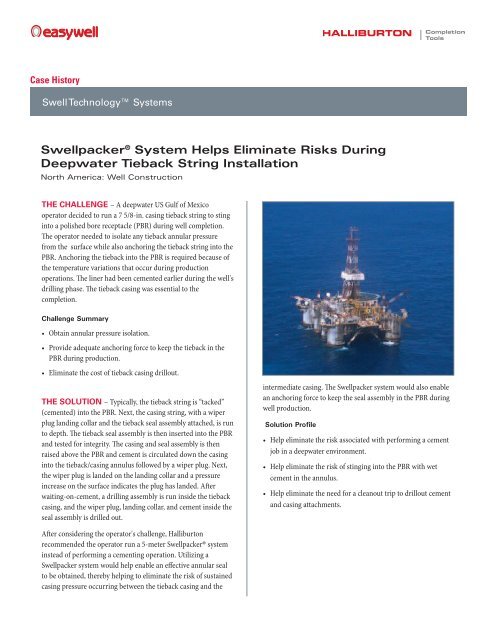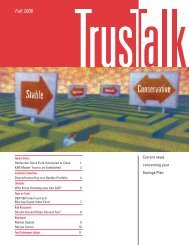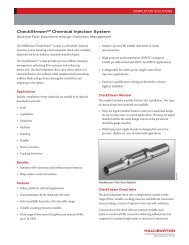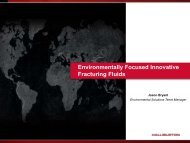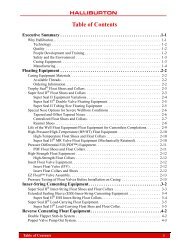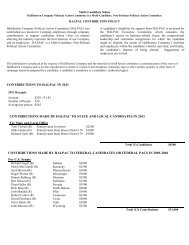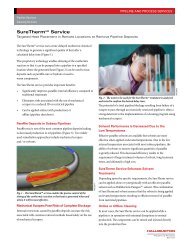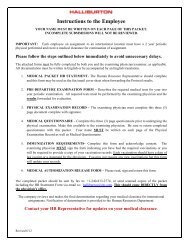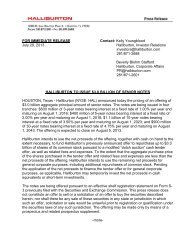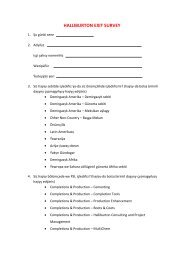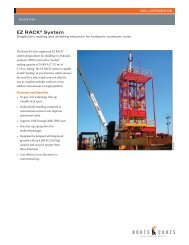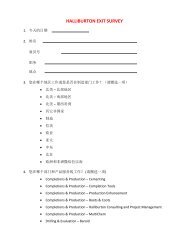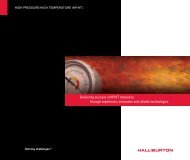H06681 North America Well Construction - Halliburton
H06681 North America Well Construction - Halliburton
H06681 North America Well Construction - Halliburton
You also want an ePaper? Increase the reach of your titles
YUMPU automatically turns print PDFs into web optimized ePapers that Google loves.
Case History<br />
SwellTechnology Systems<br />
Swellpacker ® System Helps Eliminate Risks During<br />
Deepwater Tieback String Installation<br />
<strong>North</strong> <strong>America</strong>: <strong>Well</strong> <strong>Construction</strong><br />
THE CHALLENGE – A deepwater US Gulf of Mexico<br />
operator decided to run a 7 5/8-in. casing tieback string to sting<br />
into a polished bore receptacle (PBR) during well completion.<br />
�e operator needed to isolate any tieback annular pressure<br />
from the surface while also anchoring the tieback string into the<br />
PBR. Anchoring the tieback into the PBR is required because of<br />
the temperature variations that occur during production<br />
operations. �e liner had been cemented earlier during the well's<br />
drilling phase. �e tieback casing was essential to the<br />
completion.<br />
Challenge Summary<br />
• Obtain annular pressure isolation.<br />
• Provide adequate anchoring force to keep the tieback in the<br />
PBR during production.<br />
• Eliminate the cost of tieback casing drillout.<br />
THE SOLUTION – Typically, the tieback string is “tacked”<br />
(cemented) into the PBR. Next, the casing string, with a wiper<br />
plug landing collar and the tieback seal assembly attached, is run<br />
to depth. �e tieback seal assembly is then inserted into the PBR<br />
and tested for integrity. �e casing and seal assembly is then<br />
raised above the PBR and cement is circulated down the casing<br />
into the tieback/casing annulus followed by a wiper plug. Next,<br />
the wiper plug is landed on the landing collar and a pressure<br />
increase on the surface indicates the plug has landed. A�er<br />
waiting-on-cement, a drilling assembly is run inside the tieback<br />
casing, and the wiper plug, landing collar, and cement inside the<br />
seal assembly is drilled out.<br />
A�er considering the operator's challenge, <strong>Halliburton</strong><br />
recommended the operator run a 5-meter Swellpacker® system<br />
instead of performing a cementing operation. Utilizing a<br />
Swellpacker system would help enable an e�ective annular seal<br />
to be obtained, thereby helping to eliminate the risk of sustained<br />
casing pressure occurring between the tieback casing and the<br />
intermediate casing. �e Swellpacker system would also enable<br />
an anchoring force to keep the seal assembly in the PBR during<br />
well production.<br />
Solution Profile<br />
• Help eliminate the risk associated with performing a cement<br />
job in a deepwater environment.<br />
• Help eliminate the risk of stinging into the PBR with wet<br />
cement in the annulus.<br />
• Help eliminate the need for a cleanout trip to drillout cement<br />
and casing attachments.
THE RESULTS – A 7 5/8-in. casing tieback string was<br />
installed with a 7 5/8-in. × 10-in. OD × 5-meter Swellpacker®<br />
system located just above the tieback seal assembly. �e casing<br />
was run in water-based mud. Once the tieback string was on<br />
depth, the string was lowered into the PBR and pressure tested to<br />
ensure string integrity. �en the tieback was raised to remove the<br />
seals from the PBR and 20 bbl of synthetic-based mud was<br />
circulated into the annular area around the Swellpacker system.<br />
�e tieback was lowered back into the PBR, and normal<br />
operations commenced while the Swellpacker system swelled to<br />
Swellpacker ®<br />
System<br />
Tieback Seal<br />
Assemblies<br />
Liner Hanger<br />
a�ect a seal. Once the Swellpacker system was fully operational<br />
(5 to 9 days), the Swellpacker system held 5,539 psi and provided<br />
an anchoring force of 155,000 lb.<br />
Using the Swellpacker system rather than cementing the tieback<br />
in place saved signi�cant rig time since a trip to drill cement was<br />
not required. In addition, the Swellpacker system helped<br />
eliminate the risk of not obtaining an e�ective seal when<br />
stinging into a PBR with wet cement in the casing annular area.<br />
Swellpacker<br />
System<br />
Sealed Inside<br />
Casing<br />
Tieback Seal<br />
Assemblies<br />
in Polished<br />
Bore<br />
Receptacle<br />
For more information on any of the details featured here, please contact: easywell@halliburton.com.<br />
© 2009 <strong>Halliburton</strong>. All rights reserved. Sales of <strong>Halliburton</strong> products and services will be in accord solely with the terms and conditions contained in the contract<br />
between <strong>Halliburton</strong> and the customer that is applicable to the sale. Actual results may vary in accordance with conditions and other variables. <strong>H06681</strong> 4/09<br />
www.halliburton.com


